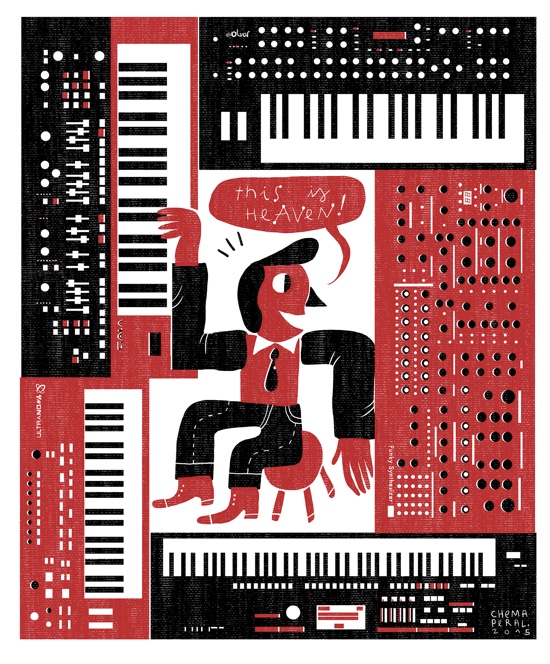I’m really pleased to have some of the UK’s small press talent reviewed this month, with superb books from Simon Moreton and Tim Bird. It looks set to be an exciting year in this arena — Avery Hill has announced several interesting titles that are on their way, and Broken Frontier are due to release a small press yearbook — so expect reviews of some of these in the future. We also have some American small press in the shape of Habit #2 from Oily and Rough House’s third anthology.
The last column began with a look at the debacle of the Angoulême festival’s failure to consider any female cartoonists for their prestigious Grand Prix. Amazingly, they found a brilliant way of diverting some of the negative attention away from this by having compere Richard Gaitet announce various prize winners at a ceremony before revealing that this was, in fact, a joke, and that none of the named people had won. It’s going to be pretty hard to see how they can top this next year, but I suppose they’ve got plenty of time to get ready.
In my review of Julia Wertz’s sublime Drinking At The Movies I erroneously stated that it looked like she was no longer cartooning. She contacted me to graciously correct this, and pointed out that she is doing monthly historical comics on the New Yorker website, and has also been tweeting some auto bio strips recently. Great news, and apologies for my mistake.
This time we have a couple of 2016 titles as well as a few from last year.
Peter Kuper — Ruins
(SelfMadeHero)
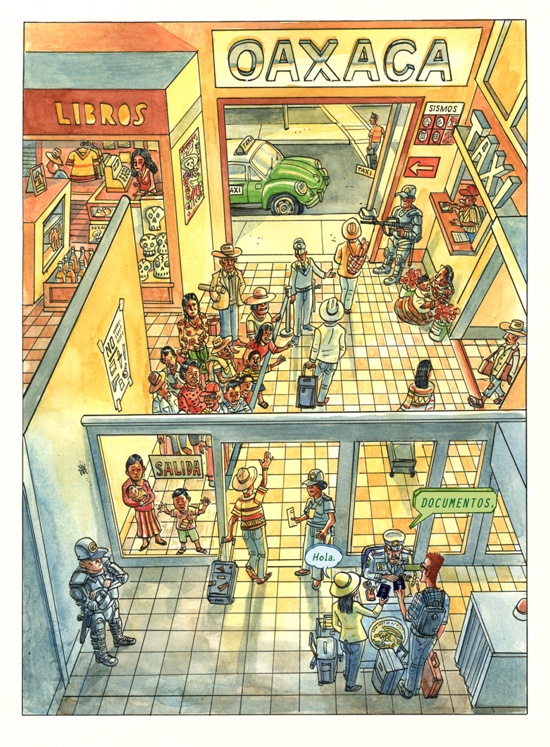
Pick up Ruins, the new graphic novel from Peter Kuper, and it’s pretty clear that SelfMadeHero have some confidence in it. It’s a big, full-colour hardback, crisply printed on thick paper, and both looks and feels fantastic. A big book with big themes, it plays out the drama of a relationship against the background of politics, history and the environment. George and Samantha move to Oaxaca, Mexico for a sabbatical, bringing more baggage than just the contents of their suitcases. He’s a newly unemployed entomologist and former artist, and his fascination with bugs is a key strand running through the book, as is the initial absence of his artistic inspiration. A chance meeting with Al, a washed-up photojournalist leads to the return of his muse, and the pair of them covers a local teachers’ strike at great personal cost. Meanwhile, Samantha is trying to finish her book and also to make sense of her past in Mexico, which includes a marriage that ended in tragedy. She’s desperate for a child, whilst George is unenthused to say the least.
The book is structured in chapters that begin with a map, before following a Monarch butterfly on a stage of its journey home to Michoacan, and finally moving to the story of the couple in Mexico. Chapters frequently end with some dramatic event which is often not directly addressed in the book. Pretty soon it becomes clear that they aren’t always being addressed by the couple either. Kuper’s art is just beautiful. The opening section in New York is mostly heavily inked two colour, with just focal objects or people in some of the panels being fully coloured. Once we arrive in Mexico, however, the palette shifts completely, the ink less pronounced and everything in glorious watercolours. The overall effect is stunning.
This is one of those books it’s hard to stop reading. Chapters are short, and the different strands of the narrative draw you in. Kuper and his family lived in Mexico for two years and this is based on their experiences there. The protagonists are fictional but the corrupt governor and the teachers’ strike are real. The combination of a great multi-layered story told with passion and through such striking artwork makes for an outstanding book – this is highly recommended. Pete Redrup
Simon Moreton — Plans We Made
(Uncivilized)
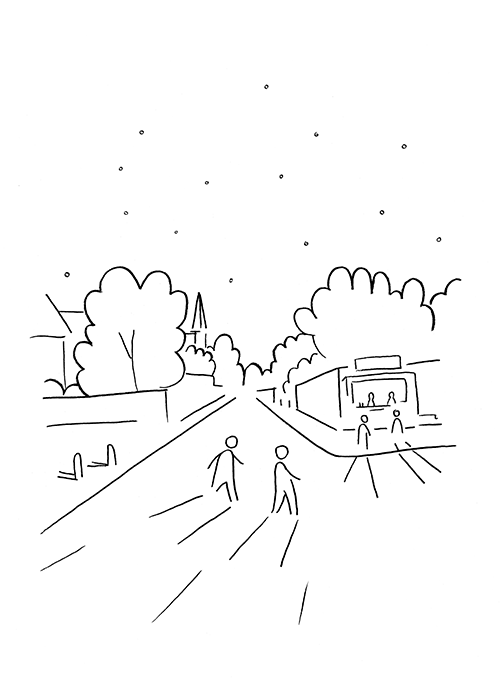
Plans We Made is the first full-length work by Simon Moreton. Well known for his long running (and recently concluded) zine SMOO, this book is both a stylistic and thematic evolution of his earlier work. It’s a memoir of his early adolescence in Marlow, drawn in his distinctive style. The first thing that strikes you is the stunning, fluid linework – the spare, minimal style allows the lines to breathe, simultaneously showing how similar they are and yet how easily and naturally they represent different things – trees, roads, clouds, houses. There’s very little text – there are few occasions when a character speaks, and often pages go by without a word. This space allows us to empathise, reflect and connect, to remember our own adolescence.
Panels are rarely bordered, and many pages are filled with a single image. When borders are used, the effect is striking. The use of empty space is significant, not just within the images, but with blank panels and blank pages too, complementing the space in the text. Moreton has also written about his teenage years in Marlow in early issues of SMOO, parts of which are collected in the excellent Avery Hill volume Days. His style has changed substantially since then. Whilst still spare by the standards of most artists, the earlier work has denser artwork and much more text. The space results in a meditative effect, mirroring the author’s focus on the internal life.
Despite the pacing, this is not a book in which nothing happens. The transition from significant family events, conveyed with masterful economy, to less significant events with friends reminds us of the way as teenagers, nothing is more important than our friends. Moreton conveys the unreliable, untrustworthy nature of our memories. The minimal style leaves out the details, reminding us of the uncertainty of adolescence when we are finding our way in the world and wondering what life holds and will hold. You can read this excellent book quickly, but you won’t be done with it for a while. Pete Redrup
Una — Becoming Unbecoming
(Myriad Editions)
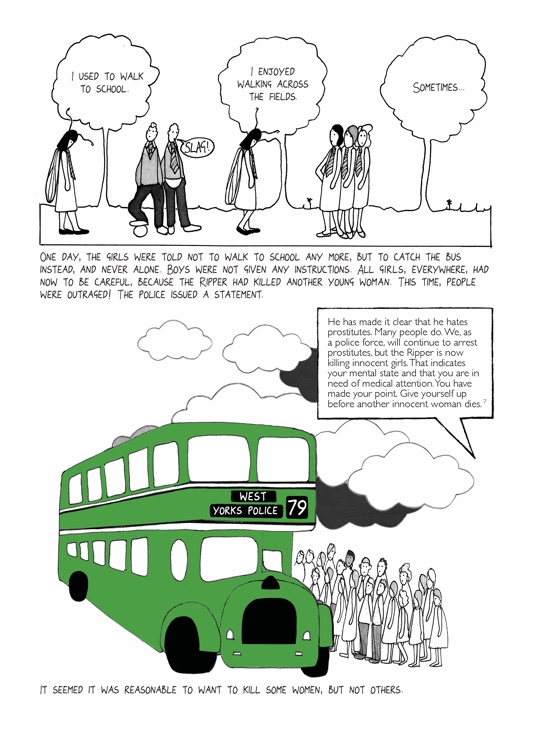
Becoming Unbecoming is the first graphic novel by Una. It’s a powerful mix of autobiography and social commentary set against the backdrop of the Yorkshire Ripper killings, which took place while the author was a young girl.
“I loved Val Doonican. He had a song called Walk Tall. He told me to walk straight and look the world right in the eye. And that’s what I tried to do.
I soon learned to lower my gaze."
Her story is one that is fundamentally about the representation and repression of women. We see this through Una, her mother, and the many victims of male violence. She recounts her own experiences of sexual exploitation, and how this led fellow pupils to label her while she was at school. She also presents statements from Yorkshire Police about the Ripper’s victims, which seem frankly astonishing until we recall the recent exploitation cases in Rotherham and elsewhere – it doesn’t seem like we’ve manage to move on. In the account of how children are abused, and how this makes them vulnerable, and difficult, often leading to blame from the police, we see exactly what the recent cases of sexual exploitation have made quite clear, that as a society we deal with this shamefully badly.
The art is varied, and brilliantly used. It’s quite an unrefined style, but so effective, blending comic panels, text, illustration, newspaper clippings, letters, and incredibly powerful abstract shapes. Take a single page in isolation and to a skeptical reader it might look preachy, polemical, and therefore worthy of dismissal. However, in the same way that you can’t assess a film by pausing on a single frame, the cumulative impact of these pages is astonishing. It’s not like we don’t know all of this already (with the exception of her personal story), but the way it is structured and paced is devastating. The final sequence is utterly heartbreaking – it functions in the same way that the final scene of Ari Folman’s Waltz With Bashir does, emotionally bringing home the realisation of what happened. Tears are likely.
In the afterword, Una writes that she hopes this is a good book, but perhaps not a worthy one. It is a very good book, an extraordinary one too. If by worthy she means “dull but worthy”, it’s not that: there’s nothing dull about this – I had to fight the urge to read it in a single sitting, and was done within 24 hours. This is an example of using the comics medium to weave a personal narrative into gender politics and produce something that is so much more than the sum of its constituent parts. Pete Redrup
Michael DeForge — Big Kids
(Drawn & Quarterly)
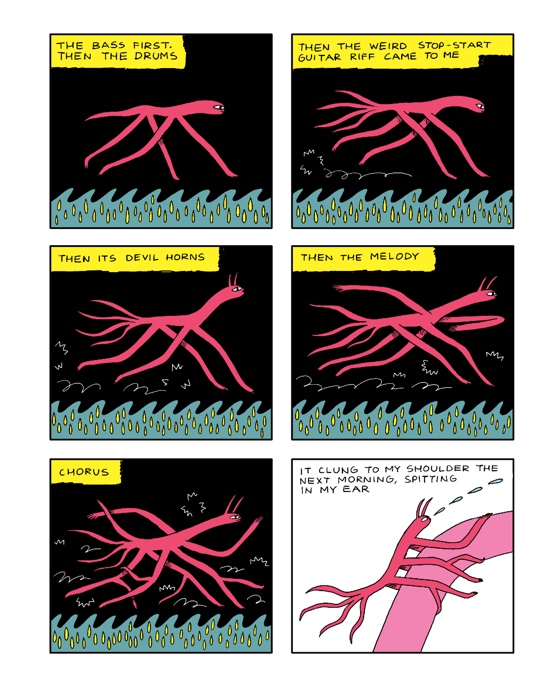
Is Michael DeForge the hardest working person in comics? Presumably his day job on Adventure Time keeps him pretty busy – it’s not like TV in general nor animation studios in particular are known for being laid back, undemanding workplaces. Yet the books keep coming. Last year he released Dressing and Lose #7 with Koyama Press, First Year Healthy with D&Q, Sensitive Property with Youth in Decline and other bits and pieces online. And here we are, barely into 2016 and we have a new full-length book, Big Kids. Actually, it may be full length, but it’s not full size – this is tiny, not much larger than a CD. The initial air of cuteness is swiftly dispelled by the content, however, despite a mostly pink and yellow colour scheme inside.
Adam is a victim of bullying by his friends and his uncle. He has a submissive role in a relationship with Jared, but when he’s dumped for Tyson, a transformation occurs. The book starts with a relatively straightforward narrative for DeForge but then becomes as bizarre as those familiar with his work might expect. As Adam’s life changes, he is guided by April, a student of his mother’s who moves in to the house early in the book. We enter a strange world – which I am reluctant to spoil – but at the same time that things depart from reality, the insights remain, the human experience of adolescence is preserved, that uncertainty and those feelings of discovery. In particular, the book captures the way trying to focus on the memory of something can make it slip away.
This is a particularly accessible book for DeForge, which maintains his distinctive aesthetic throughout, and draws us in before taking us to the simultaneously unrecognisable yet realistic, truthful world he portrays, where things change suddenly and forever. It’s an outstanding work by one of the most original voices in comics today. Pete Redrup
Tim Bird — Rock & Pop
(Self published)
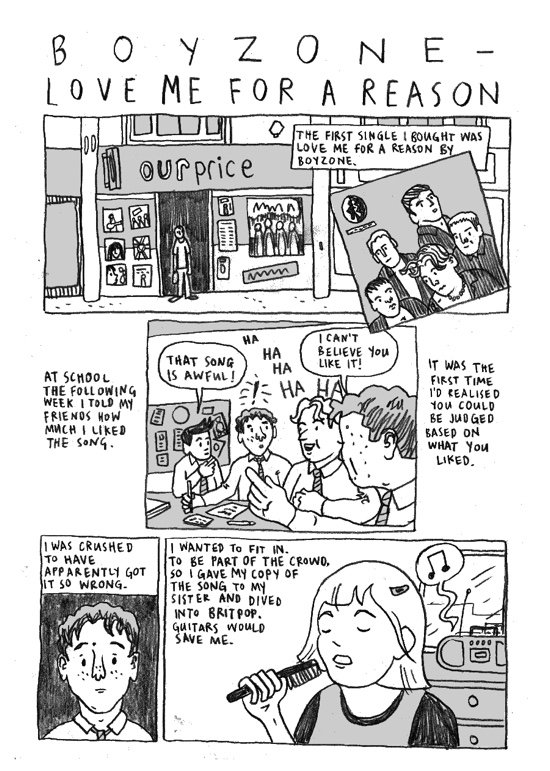
It’s a fairly safe bet that readers of tQ like music. Tim Bird’s latest comic absolutely nails the way that records accompany us through our lives, and serve as markers of particular times and places. Although we don’t have much in the way of overlapping taste (different ages), I constantly found myself grinning in recognition at what he’s captured about how music works. The format – originally a webcomic – is that each page is about a different song (the back cover lists them all on the inserts of a couple of mixtapes) and something about his life at that time.
Some pages just rang true, others made me laugh. Getting Now That’s What I Call Music cassettes for Christmas, shopping at Our Price. Buying his first single, Boyzone’s Love Me For A Reason, and realising that people will judge him based on what he likes. Getting an electric guitar but being too lazy to learn to play it properly, so using it for miming along to records instead. Being in a band, recording something then splitting up. Holding a Smashing Pumpkins themed Halloween party to listen to all the albums then going outside to smash pumpkins.
Despite the fact that this is a series of snapshots, Bird successfully weaves a charming, self-effacing narrative through the short comic. This is a warm, funny, honest and life-affirming book that should appeal to any music fan, regardless of their taste. It’s self published (and not cheaply – it’s on lovely paper with thick covers) and available from his website as well as places like Gosh! Comics and Orbital in London. Tim Bird brilliantly conveys the universal joy of music; hunt a copy out – you won’t regret it. Pete Redrup
Josh Simmons – Habit #2
(Oily)
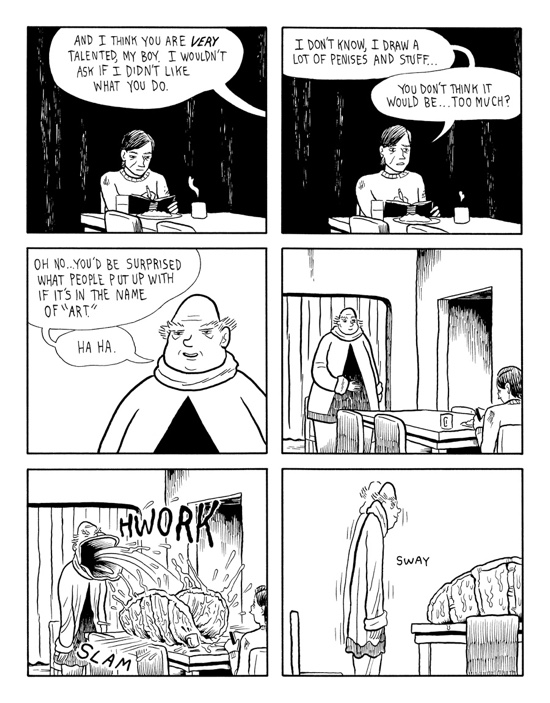
A teaser image for Habit #2 showed the cover with the New Yorker logo instead of the comic’s title – were it real, that would have been a sight to behold, depicting two self-mutilated people, bloody drinks beside them and still-burning cigarettes in an ashtray. Ah, Josh Simmons, truly you spoil us. With covers like that he’ll never fall foul of the Trade Descriptions Act – there’s no need for a Parental Advisory sticker. Habit is one of Josh Simmons’ outlets for short stories. This second issue features a long solo piece, the 33 page The Incident At Owl’s Head, and four shorter works, three of which are collaborations with Tom Van Deusen, Eric Reynolds and Ben Horak.
In the first story a drifter, Jonathan, arrives in the small seaside town of Owl’s Head. The first thing he does is walk into a beachfront gift shop and art gallery, lie down on the floor and fall asleep. For two days. When he awakes he’s told that he should go and see Ambrose, who owns the shop and allowed him to sleep there, at his huge, odd house visible through the window. He gets a warm reception and somewhere to stay, but it soon becomes apparent that Ambrose is unusual. To say more would be to spoil. This story taps into similar veins of body horror and escalating tension to Brian Yuzna’s Society which, in case you’re in any doubt, is a recommendation. The art is up to Simmon’s usual excellent standards, with a slightly comical edge to the characters and typically detailed interiors and exteriors that draw you in from the first panel. As ever, the depictions of violence are sudden and extremely gory, and we’re left in no doubt that this isn’t the first incident at Owl’s Head and won’t be the last.
Late For The Show is next, and takes a more comedic angle (as do all the collaborations) complete with punchline, although not at the expense of the horror. The response of the unsympathetic wife to the fate that befalls her husband in Bertram is priceless, whilst his fate is appalling. The Great Shitter has a grotesque, medieval quality to it, richly textured and detailed. (I just love the detail in Josh Simmon’s work. That, and the evil). For my money, this is a stronger issue than Habit #1. Indeed, within 15 minutes of my review PDF arriving I’d ordered a print copy. Highly recommended. Pete Redrup
Various — Rough House 3
(Rough House)
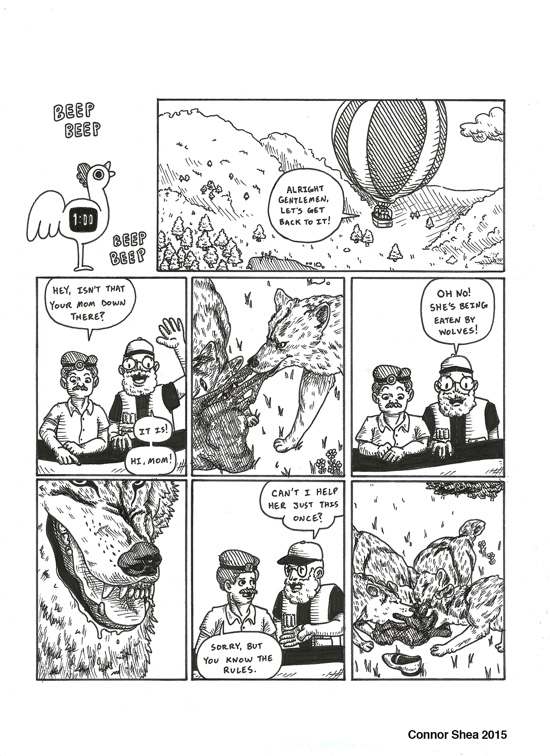
Rough House is a publisher from Austin, TX, where a good deal of their contributors are based. Keen to promote their city’s significant heritage in the comics scene, they’ve released some short run works and also an annual anthology, the third of which came out last year. Everything is printed by risograph, a distinctive style that will seem familiar to those old enough to have been at school when mimeographs were more common than photocopiers, and which provides a certain DIY charm. The process works in colour but requires a separate pass through the machine for each one used, so the strips here vary between black and white and two to three colour reproduction.
Rough House 3 features pieces by 19 artists, many of whom were unfamiliar to me, and there’s a huge variance in style. There are straightforward narratives through to fairly abstract works, and this is a great volume to leave lying about somewhere and dip into. There’s too much to review it all, but several pieces stood out to me. The book opens with Chema Peral’s story of Jam, who wants to become a famous and wealth jazz musician, despite having no musical ability. He falls in love with a synthesiser (a red Roland SH-101 – great taste) so decides to steal it, despite having no criminal ability. After an unsuccessful attempt at theft he and the instrument shop owner come up with a great solution. The Objective Observers by Connor Shea depicts three men in a hot air balloon whose job is to observe the world below, but not interfere, a requirement they struggle with. There’s plenty of subtext in here, and for me, it was one of the two standout pieces. The second is next up, a pair of Canteen Kayla strips by Kayla E, a brilliantly illustrated feminist critique. It opens with Kayla asking “what is a woman?”, to which the men in the panel reply “who cares”. Repeatedly quoting Simone de Beauvoir, Kayla’s resigned facial expression never changes throughout. Female characters are depicted in prominent black and white whilst the scenery and men are a blended pink, perfectly expressing the author’s frustration with a society that pushes women into the background. Doug Pollard’s Ajax ends the book, a terrifically drawn parable about a society with a healthcare system that can bankrupt and in doing so, sucks the life out of the people it has supposedly just saved.
This is an excellent, varied volume of considerable charm, with far more great pieces than I’ve mentioned. It’s probably not going to be easy to pick up a copy in the UK but it can be ordered from the Rough House website and is well worth the asking price. Pete Redrup
Frederik Peeters — Aama Vol. 4 – You Will Be Glorious, My Daughter
(SelfMadeHero)
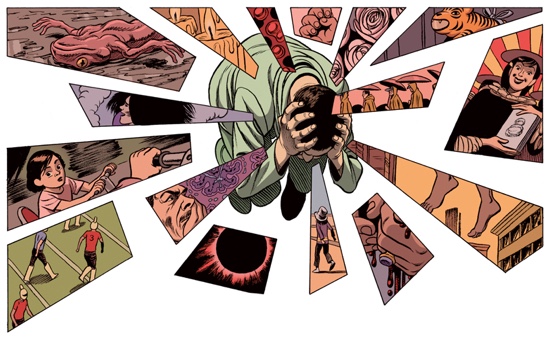
The fourth and final volume of Frederik Peeters’ stellar sci-fi series, Aama. I’ve sung its praises all along in the Quietus Comics Column and here both story and art get even more psychedelic. Something one wouldn’t have thought possible. We’re back on Verloc’s home planet where we began but now so is Aama, the viral biological experiment from Ona(ji), gaining control of life itself at a rate beyond alarming. Our anti-hero Verloc is given tremendous vitality from Aama now firmly entrenched in his body and psyche and the battle rages at all levels as Verloc races to save his mute daughter, with whom it seems Aama has an affinity. But first Verloc must defeat the evil scientist and his entourage who are behind this experiment gone mad. Peeters does a wonderful job of – like his hero Moebius – depicting the outer forms of inner struggle. His double page spreads, centering each on a face, are outstanding, delivering quite an impact, not only narrative-wise but also in respect of his talent and imagination. In hindsight we can now see the threads that have been pulling this wild story, though the end still comes as an unsettling surprise. Aug Stone

